l国际金融新编(第三章)
- 格式:ppt
- 大小:425.50 KB
- 文档页数:55
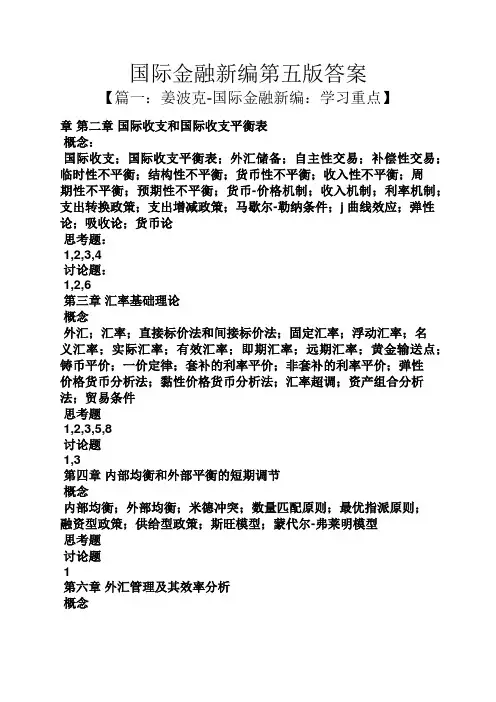
国际金融新编第五版答案【篇一:姜波克-国际金融新编:学习重点】章第二章国际收支和国际收支平衡表概念:国际收支;国际收支平衡表;外汇储备;自主性交易;补偿性交易;临时性不平衡;结构性不平衡;货币性不平衡;收入性不平衡;周期性不平衡;预期性不平衡;货币-价格机制;收入机制;利率机制;支出转换政策;支出增减政策;马歇尔-勒纳条件;j曲线效应;弹性论;吸收论;货币论思考题:1,2,3,4讨论题:1,2,6第三章汇率基础理论概念外汇;汇率;直接标价法和间接标价法;固定汇率;浮动汇率;名义汇率;实际汇率;有效汇率;即期汇率;远期汇率;黄金输送点;铸币平价;一价定律;套补的利率平价;非套补的利率平价;弹性价格货币分析法;黏性价格货币分析法;汇率超调;资产组合分析法;贸易条件思考题1,2,3,5,8讨论题1,3第四章内部均衡和外部平衡的短期调节概念内部均衡;外部均衡;米德冲突;数量匹配原则;最优指派原则;融资型政策;供给型政策;斯旺模型;蒙代尔-弗莱明模型思考题讨论题1第六章外汇管理及其效率分析概念影子汇率;固定汇率制;浮动汇率制;棘轮效应;三元悖论;爬行盯住;汇率目标区;货币局制度;国际清偿力;国际储备;特别提款权;备用信贷;冲销式干预;非冲销式干预;货币替代思考题2,4讨论题1,2,3第七章金融全球化对内外均衡的冲击概念国际金融市场;国际货币市场;国际资本市场;欧洲货币市场;伦敦银行同业拆放利率;离岸交易;在岸交易;欧洲债券;外国债券;银行危机;货币危机思考题2,5,6讨论题2,3第八章金融全球化下的国际协调与合作概念国际货币体系;国际金本位制;布雷顿森林体系;双挂钩;特里芬两难;牙买加体系;国际货币基金组织;巴拉萨-萨缪尔森效应;区域货币合作思考题2,3,4讨论题2,3,5【篇二:国际金融练习题】=txt>(答案请参照姜波克的《国际金融新编习题指南》的各章)第一章一、基本概念国际收支国际收支平衡表贸易收支差额经常账户差额资本和金融账户差额自主性交易补偿性交易二、简答题1、简述国际收支平衡表的基本内容2、简述国际收支各账户之间的关系3、请简述国际收支不平衡性质4、简述国际收支失衡的影响三、选择题(单项或多项)1?下列项目应记入贷方的是:()A?反映进口实际资源的经常项目B?反映出口实际资源的经常项目C?反映资产增加或负债减少的金融项目D?反映资产减少或负债增加的金融项目2?国际收支反映的内容是以交易为基础的,其中交易包括:()A?交换B?转移C?移居D?其他根据推论而存在的交易3?国际收支的长期性不平衡包括:()A临时性不平衡B结构性不平衡C货币性不平衡D周期性不平衡E.收入性不平衡4?《国际收支手册》第五版将国际收支账户分为:()A?经常账户B?资本与金融账户C?储备账户D?错误和遗漏账户5?下列哪个(些)账户能够较好地衡量国际收支对国际储备造成的压力:()A?贸易收支差额B?经常项目收支差额C?资本和金融账户差额D?综合账户差额6?若在国际收支平衡表中,储备资产项目为-100亿美元,则表示该国:()A?增加了100亿美元的储备B?减少了100亿美元的储备C?人为的账面平衡,不说明问题D?无法判断四、计算分析题:(1)该国该年BOP差额是多少?(2)请简要分析一下该国的国际收支平衡状况。


姜波克《国际金融新编》第6版考研章节题库第三章汇率基础理论一、概念题1.货币资产效应答:货币资产效应是一种本币贬值对经济总需求的紧缩性影响效应。
从货币理论和金融资产的角度看,本币贬值使本国货币购买金融资产尤其是外币资产的能力下降,它把较多的本国购买力转移到了相同数量的外币资产上,从而也会导致总需求的萎缩,这是“货币资产效应”。
2.债务效应答:债务效应是一种本币贬值对经济总需求的紧缩性影响效应。
本币贬值后,偿还相同数额的外债需要付出更多的本国货币。
当外债还本付息额较大时,贬值必会引起国内总需求下降。
3.贬值税效应答:贬值税效应是一种本币贬值对经济总需求的紧缩性影响效应。
随着我国经济建设的发展和农村耕地面积的减少,高新技术、设备、能源以及粮食等需求弹性很低的进口商品越来越必要。
本币贬值后我国货币购买力的较大部分将转向这些进口商品,从而导致对本国产品的相对需求下降,这实际上是本币贬值加在社会总需求上的一种赋税,称为“贬值税效应”。
4.金币本位制答:金本位制最初是指金币本位制,即以黄金为货币制度的基础,黄金直接参与流通的货币制度。
在金币本位制度下,各国都规定金币的法定含金量,具有无限法偿能力。
两种不同货币之间的比价,由它们各自的含金量对比来决定。
在金本位制度下,汇率决定的基础是铸币平价。
实际经济中的汇率则因供求关系而围绕铸币平价上下波动,但其波动的幅度受制于黄金输送点。
5.金块本位制答:金币本位制度发展到后期,由于黄金产量跟不上经济发展对货币日益增长的需求,黄金参与流通、支付的程度下降,其作用逐渐被以其为基础的纸币所取代。
只有当大规模支付需要时,黄金才出马,以金块的形式参与流通和支付。
这种形式的货币制度,我们又称它为金块本位制。
金块本位制依然是一种金本位制,因为在这种制度下,纸币的价值是以黄金为基础,代表黄金流通,并与黄金保持固定的比价。
黄金仍在一定程度上参与清算和支付。
6.外汇汇率答:外汇汇率是以另一国货币来表示本国货币的价格。
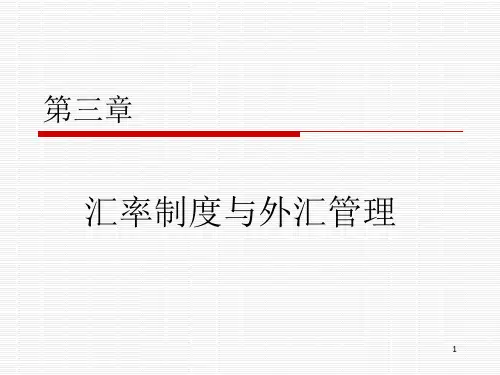
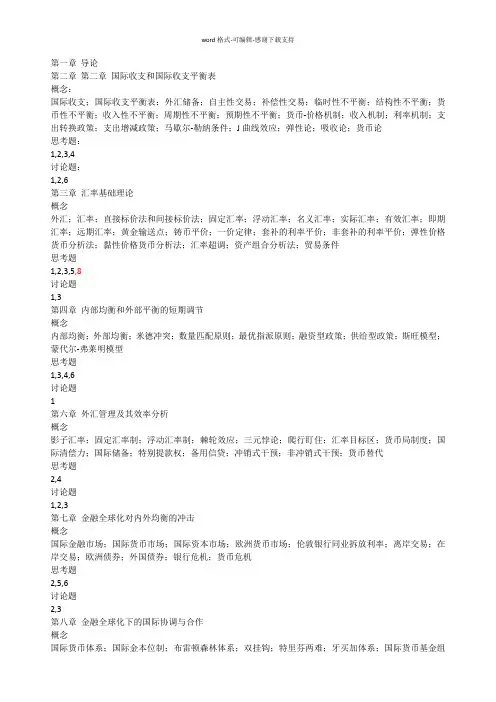
第一章导论第二章第二章国际收支和国际收支平衡表概念:国际收支;国际收支平衡表;外汇储备;自主性交易;补偿性交易;临时性不平衡;结构性不平衡;货币性不平衡;收入性不平衡;周期性不平衡;预期性不平衡;货币-价格机制;收入机制;利率机制;支出转换政策;支出增减政策;马歇尔-勒纳条件;J曲线效应;弹性论;吸收论;货币论思考题:1,2,3,4讨论题:1,2,6第三章汇率基础理论概念外汇;汇率;直接标价法和间接标价法;固定汇率;浮动汇率;名义汇率;实际汇率;有效汇率;即期汇率;远期汇率;黄金输送点;铸币平价;一价定律;套补的利率平价;非套补的利率平价;弹性价格货币分析法;黏性价格货币分析法;汇率超调;资产组合分析法;贸易条件思考题1,2,3,5,8讨论题1,3第四章内部均衡和外部平衡的短期调节概念内部均衡;外部均衡;米德冲突;数量匹配原则;最优指派原则;融资型政策;供给型政策;斯旺模型;蒙代尔-弗莱明模型思考题1,3,4,6讨论题1第六章外汇管理及其效率分析概念影子汇率;固定汇率制;浮动汇率制;棘轮效应;三元悖论;爬行盯住;汇率目标区;货币局制度;国际清偿力;国际储备;特别提款权;备用信贷;冲销式干预;非冲销式干预;货币替代思考题2,4讨论题1,2,3第七章金融全球化对内外均衡的冲击概念国际金融市场;国际货币市场;国际资本市场;欧洲货币市场;伦敦银行同业拆放利率;离岸交易;在岸交易;欧洲债券;外国债券;银行危机;货币危机思考题2,5,6讨论题2,3第八章金融全球化下的国际协调与合作概念国际货币体系;国际金本位制;布雷顿森林体系;双挂钩;特里芬两难;牙买加体系;国际货币基金组织;巴拉萨-萨缪尔森效应;区域货币合作思考题2,3,4讨论题2,3,5。
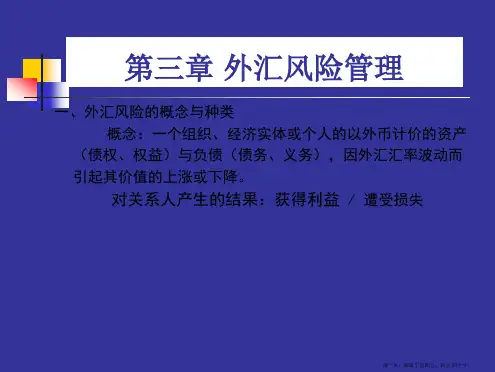

第三章汇率基础理论3.1 复习笔记考点一、外汇和汇率的基本概念1.外汇(1)外汇的概念外汇是指外国货币或以外国货币表示的、为各国普遍接受的、能用来清算国际收支差额的资产。
(2)一种外币成为外汇的三个前提条件①自由兑换性,即这种外币能自由地兑换成本币;②普遍接受性,即这种外币在国际贸易往来中被各国普遍接受和使用;③可偿性,即这种外币资产是可以保证方便地得到偿付的。
(3)我国规定的外汇具体范围①外国货币,包括纸币、铸币;②外币支付凭证,包括票据、银行存款凭证、邮政储蓄凭证等;③外币有价证券,包括政府债券、公司债券、股票等;④特别提款权;⑤其他外汇资产。
2.汇率及汇率的表示(1)汇率的概念汇率就是以一种货币表示的另一种货币的价格,它是两种货币之间的折算比价。
(2)汇率的表达方式①直接标价法:固定外国货币的数量,以本国货币表示这一固定数量的外国货币的价格。
若无特殊说明,一般用直接标价法来表示汇率。
用数学公式来表达可以写成:本国货币数量/固定的外国货币数量。
②间接标价法:固定本国货币的数量,以外国货币表示这一固定数量的本国货币的价格。
用数学公式可以写成:外国货币数量/固定的本国货币数量。
3.汇率变动的计算及外汇交易种类(1)汇率变动的计算汇率变动的计算与商品价格变动的计算在原理上是相同的。
根据这个原理,A币直接标价法下的汇率原价为e0,变动后的汇率现价为e1,A币的升值率和贬值率或其汇率的上升率和下降率,可以用以下两组公式来分别表示:A币币值的升值率或A币汇率上升率=A币升值的增加值/A币原值=(e1-e0)/e0 A币币值的贬值率或A币汇率下降率=A币升值的减少值/A币原值=(e0-e1)/e0(2)套汇交易和抵补套利交易①套汇,当同一货币的汇率在不同外汇市场上存在差异时,市场参与者通过在外汇汇率较低的市场上买进外汇,在外汇汇率较高的市场上卖出外汇来获得收益的行为。
②抵补套利,利用两国金融市场短期利率的差异,将资金从低利率国家调动到高利率国家以赚取利息差额,并同时购入远期外汇以锁定汇率、消除汇率风险的活动。
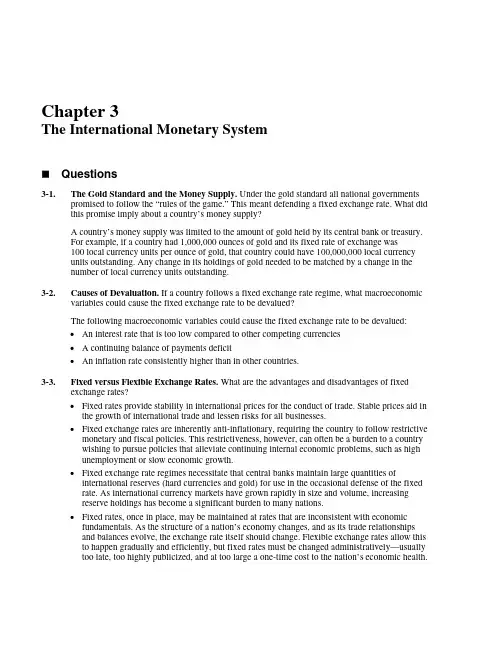
Chapter 3The International Monetary SystemQuestions3-1. The Gold Standard and the Money Supply. Under the gold standard all national governments promised to follow the “rules of the game.” This meant defending a fixed exchange rate. What did this promise imply about a country’s money supply?A country’s money supply was limited to the amount of gold held by its central bank or treasury.For example, if a country had 1,000,000 ounces of gold and its fixed rate of exchange was100 local currency units per ounce of gold, that country could have 100,000,000 local currencyunits outstanding. Any change in its holdings of gold needed to be matched by a change in thenumber of local currency units outstanding.3-2. Causes of Devaluation. If a country follows a fixed exchange rate regime, what macroeconomic variables could cause the fixed exchange rate to be devalued?The following macroeconomic variables could cause the fixed exchange rate to be devalued:•An interest rate that is too low compared to other competing currencies• A continuing balance of payments deficit•An inflation rate consistently higher than in other countries.3-3. Fixed versus Flexible Exchange Rates. What are the advantages and disadvantages of fixed exchange rates?•Fixed rates provide stability in international prices for the conduct of trade. Stable prices aid in the growth of international trade and lessen risks for all businesses.•Fixed exchange rates are inherently anti-inflationary, requiring the country to follow restrictive monetary and fiscal policies. This restrictiveness, however, can often be a burden to a countrywishing to pursue policies that alleviate continuing internal economic problems, such as highunemployment or slow economic growth.•Fixed exchange rate regimes necessitate that central banks maintain large quantities of international reserves (hard currencies and gold) for use in the occasional defense of the fixedrate. As international currency markets have grown rapidly in size and volume, increasingreserve holdings has become a significant burden to many nations.•Fixed rates, once in place, may be maintained at rates that are inconsistent with economic fundamentals. As the structure of a nation’s economy changes, and as its trade relationshipsand balances evolve, the exchange rate itself should change. Flexible exchange rates allow thisto happen gradually and efficiently, but fixed rates must be changed administratively—usuallytoo late, too highly publicized, and at too large a one-time cost to the nation’s economic health.Chapter 3 The International Monetary System 13 3-4. The Impossible Trinity. Explain what is meant by the term impossible trinity and why it is true.•Countries with floating rate regimes can maintain monetary independence and financial integration but must sacrifice exchange rate stability.•Countries with tight control over capital inflows and outflows can retain their monetary independence and stable exchange rate, but surrender being integrated with the world’scapital markets.•Countries that maintain exchange rate stability by having fixed rates give up the ability to have an independent monetary policy.3-5. Currency Board or Dollarization. Fixed exchange rate regimes are sometimes implemented through a currency board (Hong Kong) or dollarization (Ecuador). What is the difference between the two approaches?In a currency board arrangement, the country issues its own currency but that currency is backed 100% by foreign exchange holdings of a hard foreign currency—usually the U.S. dollar.In dollarization, the country abolishes its own currency and uses a foreign currency, such asthe U.S. dollar, for all domestic transactions.3-6. Emerging Market Exchange Rate Regimes. High capital mobility is forcing emerging market nations to choose between free-floating regimes and currency board or dollarization regimes. What are the main outcomes of each of these regimes from the perspective of emerging market nations?There is no doubt that for many emerging markets a currency board, dollarization, and freely-floating exchange rate regimes are all extremes. In fact, many experts feel that the global financial marketplace will drive more and more emerging market nations towards one of these extremes. As illustrated by Exhibit 3.6 (in the chapter and reproduced here), there is a distinct lack of “middle ground” left between rigidly fixed and freely floating. In anecdotal support of this argument,a poll of the general population in Mexico in 1999 indicated that 9 out of 10 people would preferdollarization over a floating-rate peso. Clearly, there are many in the emerging markets of theworld who have little faith in their leadership and institutions to implement an effective exchange rate policy.14 Eiteman/Stonehill/Moffett •Multinational Business Finance, Twelfth Edition3-7. Argentine Currency Board. How did the Argentine currency board function from 1991 to January 2002 and why did it collapse?Argentina’s currency board exchange regime of fixing the value of its peso on a one-to-one basis with the U.S. dollar ended for several reasons.•As the U.S. dollar strengthened against other major world currencies, including the euro, during the 1990s, Argentine export prices rose vis-à-vis the currencies of its major trading partners.•This problem was aggravated by the devaluation of the Brazilian real in the late 1990s.•These two problems, in turn, led to continued trade deficits and a loss of foreign exchange reserves by the Argentine central bank. (4) This problem, in turn, led Argentine residents toflee from the peso and into the dollar, further worsening Argentina’s ability to maintain itsone-to-one peg.Euro.On January 4, 1999, eleven member states of the European Union initiated the3-8. TheEuropean Monetary Union (EMU) and established a single currency, the euro, which replacedthe individual currencies of participating member states. Describe three of the main ways thatthe euro affects the members of the EMU.The euro affects markets in three ways: (1) countries within the euro zone enjoy cheaper transaction costs; (2) currency risks and costs related to exchange rate uncertainty are reduced; and (3) allconsumers and businesses both inside and outside the euro zone enjoy price transparency andincreased price-based competition.The United Kingdom, Denmark, and Sweden have chosen not to adopt the euro but 3-9. Maveri c ks.rather maintain their individual currencies. What are the motivations of each of these three countries that are also members of the European Union?The United Kingdom chose not to adopt the euro because of the extensive use of the U.K. pound in international trade and financial transactions. London is still the world’s most importantfinancial center. The British are also very proud of their long tradition in financial matters when “Britannia ruled the waves.” They are afraid that monetary and financial matters may eventually migrate to Frankfurt where the European Central Bank is located. The British are also worriedabout continued concentration of decision making in Brussels where the main European Unioninstitutions are located.Denmark is also worried about losing its economic independence as a small country surrounded by big neighbors. Denmark’s currency, the krone, is mostly tied to the euro anyway, so it does not suffer a misalignment with the primary currency unit of the surrounding economies. Sweden has strong economic ties to Denmark, Norway, and the United Kingdom, none of which adopted the euro so far. Sweden, like the others, is afraid of over-concentration of power within EuropeanUnion institutions.Despite popular fears and a certain amount of nationalism, all three countries have strong forces within that would like these countries to adopt the euro. This would usually require popularreferendums, so you may see them adopt the euro in the future.Chapter 3 The International Monetary System 15 3-10. International Monetary Fund (IMF). The IMF was established by the Bretton Woods Agreement (1944). What were its original objectives?The IMF was established to render temporary assistance to member countries trying to defend the value of their currencies against cyclical, seasonal, or random occurrences. Additionally it was to assist countries having structural trade problems. More recently it has attempted to help countries, such as Russia, Brazil, Argentina, and Indonesia, to resolve financial crises.3-11. Special Drawing Rights. What are Special Drawing Rights?The Special Drawing Right (SDR) is an international reserve asset created by the IMF to supplement existing foreign exchange reserves. It serves as a unit of account for the IMF and other international and regional organizations and is also the base against which some countries peg the exchangerate for their currencies.Defined initially in terms of a fixed quantity of gold, the SDR has been redefined several times.It is currently the weighted value of currencies of the five IMF members having the largest exports of goods and services. Individual countries hold SDRs in the form of deposits in the IMF. These holdings are part of each country’s international monetary reserves, along with official holdings of gold, foreign exchange, and its reserve position at the IMF. Members may settle transactionsamong themselves by transferring SDRs.3-12. Exchange Rate Regime Classifications. The IMF classifies all exchange rate regimes into eight specific categories that are summarized in this chapter. Under which exchange rate regime would you classify each of the following countries?a. France: Exchange arrangements with no separate legal tender.b. The United States: independent floating.c. Japan: independent floating.d. Thailand: managed floating with no pre-announced path for the exchange rate. Prior to theAsian Crisis of 1997 it was tied to the U.S. dollar.3-13. The Ideal Currency. What are the attributes of the ideal currency?If the ideal currency existed in today’s world, it would possess three attributes (illustrated inExhibit 3.4), often referred to as The Impossible Trinity.a.Exchange rate stability. The value of the currency would be fixed in relationship to othermajor currencies so traders and investors could be relatively certain of the foreign exchangevalue of each currency in the present and into the near future.b. Full financial integration. Complete freedom of monetary flows would be allowed, so tradersand investors could willingly and easily move funds from one country and currency to anotherin response to perceived economic opportunities or risks.c. Monetary independen c e. Domestic monetary and interest rate policies would be set by eachindividual country to pursue desired national economic policies, especially as they mightrelate to limiting inflation, combating recessions, and fostering prosperity and full employment.The reason that it is termed The Impossible Trinity is that a country must give up one of the three goals described by the sides of the triangle, monetary independence, exchange rate stability, orfull financial integration. The forces of economics do not allow the simultaneous achievement of all three.16 Eiteman/Stonehill/Moffett •Multinational Business Finance, Twelfth Edition3-14. Bretton Woods Failure. Why did the fixed exchange rate regime of 1945–1973 eventually fail?The fixed exchange rate regime of 1945–1973 failed because of widely diverging nationalmonetary and fiscal policies, differential rates of inflation, and various unexpected externalshocks. The U.S. dollar was the main reserve currency held by central banks and was the key to the web of exchange rate values. The United States ran persistent and growing deficits in itsbalance of payments, which required a heavy outflow of dollars to finance the deficits. Eventually the heavy overhang of dollars held by foreigners forced the United States to devalue the dollarbecause the United States was no longer able to guarantee conversion of dollars into its diminishing store of gold.3-15. EU and Euro Expansion. With so many new countries joining the European Union in 2004, when will they officially move to the euro—if ever?In January 2007 two more countries were added to the EU’s growing membership—Bulgaria and Romania. Their entry was little more than two years after the EU had added 10 more countriesto its ranks. As illustrated by Global Finance in Practice 3.2, to date only one of these new12 members has actually adopted the euro. Although all members are expected to eventuallyreplace their currencies with the euro, recent years have seen growing debates and continualpostponements by the new members in moving toward full euro adoption.。
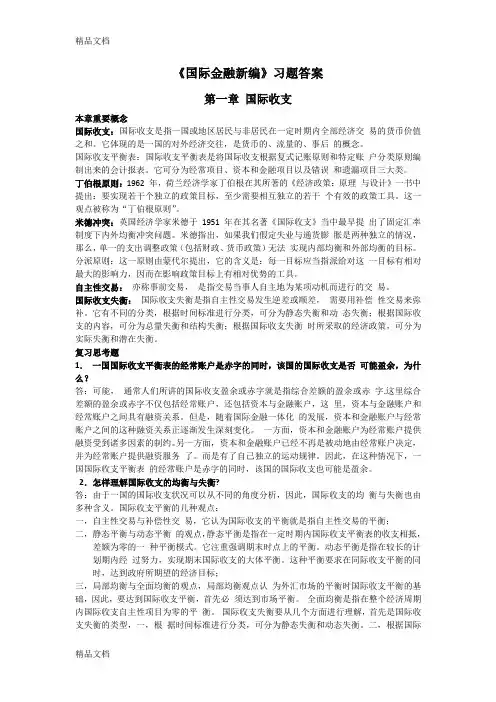
《国际金融新编》习题答案第一章国际收支本章重要概念国际收支:国际收支是指一国或地区居民与非居民在一定时期内全部经济交易的货币价值之和。
它体现的是一国的对外经济交往,是货币的、流量的、事后的概念。
国际收支平衡表:国际收支平衡表是将国际收支根据复式记账原则和特定账户分类原则编制出来的会计报表。
它可分为经常项目、资本和金融项目以及错误和遗漏项目三大类。
丁伯根原则:1962 年,荷兰经济学家丁伯根在其所著的《经济政策:原理与设计》一书中提出:要实现若干个独立的政策目标,至少需要相互独立的若干个有效的政策工具。
这一观点被称为“丁伯根原则”。
米德冲突:英国经济学家米德于1951 年在其名著《国际收支》当中最早提出了固定汇率制度下内外均衡冲突问题。
米德指出,如果我们假定失业与通货膨胀是两种独立的情况,那么,单一的支出调整政策(包括财政、货币政策)无法实现内部均衡和外部均衡的目标。
分派原则:这一原则由蒙代尔提出,它的含义是:每一目标应当指派给对这一目标有相对最大的影响力,因而在影响政策目标上有相对优势的工具。
自主性交易:亦称事前交易,是指交易当事人自主地为某项动机而进行的交易。
国际收支失衡:国际收支失衡是指自主性交易发生逆差或顺差,需要用补偿性交易来弥补。
它有不同的分类,根据时间标准进行分类,可分为静态失衡和动态失衡;根据国际收支的内容,可分为总量失衡和结构失衡;根据国际收支失衡时所采取的经济政策,可分为实际失衡和潜在失衡。
复习思考题1.一国国际收支平衡表的经常账户是赤字的同时,该国的国际收支是否可能盈余,为什么?答:可能,通常人们所讲的国际收支盈余或赤字就是指综合差额的盈余或赤字.这里综合差额的盈余或赤字不仅包括经常账户,还包括资本与金融账户,这里,资本与金融账户和经常账户之间具有融资关系。
但是,随着国际金融一体化的发展,资本和金融账户与经常账户之间的这种融资关系正逐渐发生深刻变化。
一方面,资本和金融账户为经常账户提供融资受到诸多因素的制约。
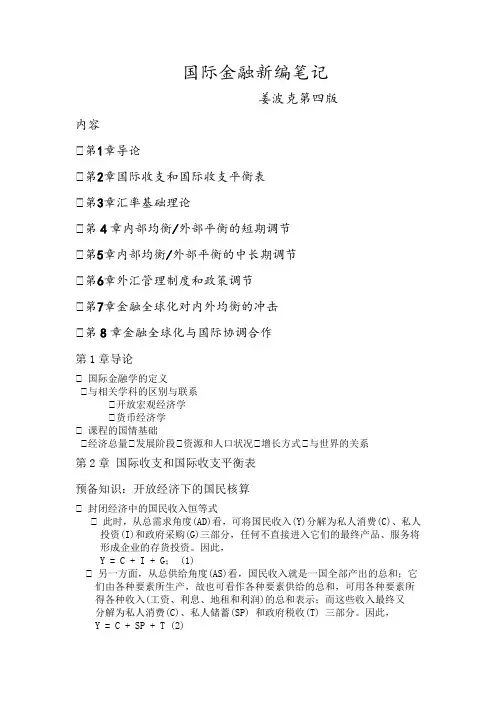
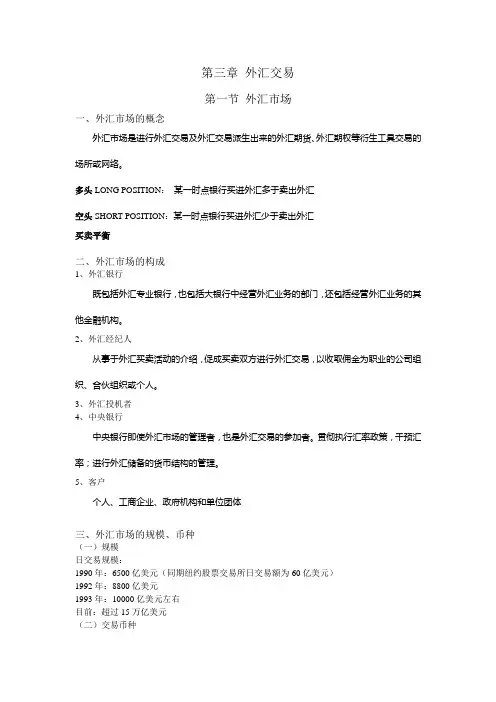
第三章外汇交易第一节外汇市场一、外汇市场的概念外汇市场是进行外汇交易及外汇交易派生出来的外汇期货、外汇期权等衍生工具交易的场所或网络。
多头LONG POSITION:某一时点银行买进外汇多于卖出外汇空头SHORT POSITION:某一时点银行买进外汇少于卖出外汇买卖平衡二、外汇市场的构成1、外汇银行既包括外汇专业银行,也包括大银行中经营外汇业务的部门,还包括经营外汇业务的其他金融机构。
2、外汇经纪人从事于外汇买卖活动的介绍,促成买卖双方进行外汇交易,以收取佣金为职业的公司组织、合伙组织或个人。
3、外汇投机者4、中央银行中央银行即使外汇市场的管理者,也是外汇交易的参加者。
贯彻执行汇率政策,干预汇率;进行外汇储备的货币结构的管理。
5、客户个人、工商企业、政府机构和单位团体三、外汇市场的规模、币种(一)规模日交易规模:1990年:6500亿美元(同期纽约股票交易所日交易额为60亿美元)1992年:8800亿美元1993年:10000亿美元左右目前:超过15万亿美元(二)交易币种1999年以前:大部分交易集中在美元$、德国马克DM、日元¥、英镑£、瑞士法郎SF、加拿大元Can$、法国法郎FF、澳大利亚元Aus$、荷兰盾DG、比利时法郎BF和意大利里拉IL。
1999年以后:美元、欧元、日元、瑞士法郎、英镑、加元四、外汇市场的类型(一)有形外汇市场与无形外汇市场有形外汇市场:在集中的、固定的场所即外汇交易所进行外汇交易的市场无形外汇市场:不在集中的、固定的场所,而分散在各个银行通过柜台业务与电讯方式进行外汇交易的市场,亦称:柜台市场,OTC市场。
交易不受时间、地点的限制,可昼夜不间断地进行交易活动。
(二)狭义外汇市场与广义外汇市场狭义外汇市场:银行之间进行外汇交易的市场广义外汇市场:既包括银行之间进行外汇交易的市场,也包括银行与客户之间进行外汇交易的市场,零售市场(三)即期外汇市场与远期外汇市场即期外汇市场:外汇交易达成后,买卖双方须在2个营业日之内办理交割手续的市场远期外汇市场:外汇交易达成并签订契约,买卖双方按照契约的规定,在将来某个时日办理交割活动的市场(四)传统外汇市场与衍生外汇市场传统的外汇市场:进行原生工具外汇买卖的市场衍生市场:即进行从外汇交易派生出来的衍生工具交易的市场(五)自由外汇市场、平行外汇市场与黑市自由外汇市场:外汇供给需各方基本上不受限制地进行外汇买卖的场所。
姜波克《国际金融新编》(第6版)笔记和课后习题(含考研真题)详解完整版>精研学习䋞>无偿试用20%资料
全国547所院校视频及题库资料
考研全套>视频资料>课后答案>往年真题>职称考试
目录
隐藏
第一章导论
1.1复习笔记
1.2课后习题详解
1.3考研真题与典型题详解
第二章国际收支和国际收支平衡表
2.1复习笔记
2.2课后习题详解
2.3考研真题与典型题详解
第三章汇率基础理论
3.1复习笔记
3.2课后习题详解
3.3考研真题与典型题详解
第四章内部均衡和外部平衡的短期调节4.1复习笔记
4.2课后习题详解
4.3考研真题与典型题详解
第五章内部均衡和外部平衡的中长期调节5.1复习笔记
5.2课后习题详解
5.3考研真题与典型题详解
第六章外汇管理及其效率分析
6.1复习笔记
6.2课后习题详解
6.3考研真题与典型题详解
第七章金融全球化对内外均衡的冲击7.1复习笔记
7.2课后习题详解
7.3考研真题与典型题详解
第八章金融全球化下的国际协调与合作8.1复习笔记
8.2课后习题详解
8.3考研真题与典型题详解。